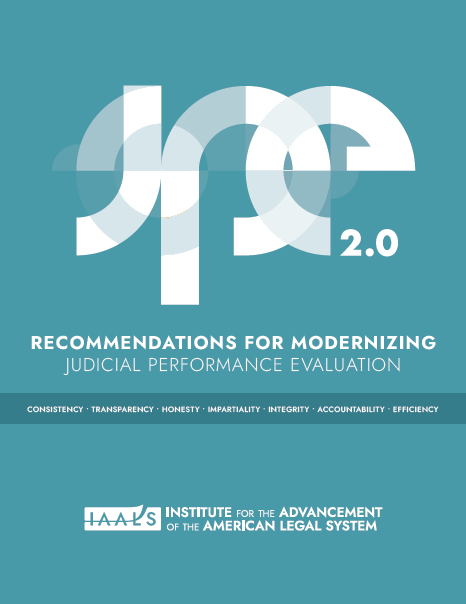Most Americans undergo job evaluations, and there is no reason why judges should not do the same. Judicial performance evaluation (JPE) processes were first developed in the 1980s and provide a foundation for states to assess the job performance of judges. Today, JPE programs continue to focus on the right goal of holding judges accountable to high quality job performance while maintaining judicial independence, by focusing on politically neutral qualities like impartiality, case administration, and clarity of communication rather than specific case outcomes. However, updating evaluation methods is essential to keeping JPE relevant and useful. Current JPE processes no longer fully capture the experience of modern court users, the needs of modern judges, or the expectations of modern voters.
IAALS’ multi-year JPE 2.0 project is helping JPE programs update their approaches to reflect modern realities, while remaining accurate, trusted, and relevant.
Recommendations for Modernizing Judicial Performance Evaluation
- An overview of the JPE 2.0 project, including guiding principles and key considerations.
- A summary of the challenges and opportunities facing JPE programs.
- Six detailed and actionable recommendations to modernize JPE, which can be adapted to fit each state's culture and needs:
- Foster trust and confidence in the JPE process.
- Modernize the evaluation criteria to account for the changing roles and responsibilities of the judiciary.
- Implement measures to improve information and reduce errors in evaluations.
- Build a culture of and embrace judicial performance improvement as a key aspect of JPE.
- Display institutional commitment to JPE.
- Ensure and improve transparency for intended audiences.
- Next steps for states and courts to take action, including implementation strategies for states with and without JPE programs.
Other JPE Resources
- A Primer on JPE: IAALS discusses the general purposes and history of JPE; the various evaluation criteria, tools, and procedures used in JPE programs; the varying perspectives on JPE; and issues in the realm of JPE warranting focused consideration going forward.
- National Perspectives on Judicial Performance Evaluation: IAALS surveyed judges across eight states—Alaska, Colorado, Hawaii, Idaho, Massachusetts, New Mexico, Utah, and Virginia—to understand their perspectives on JPE, what is working well, and challenges with their programs. Our report reveals their insights and informed the JPE 2.0 recommendations.
- The O’Connor Judicial Selection Plan: JPE is a cornerstone of our model for choosing, evaluating, and retaining judges, developed by IAALS and U.S. Supreme Court Justice Sandra Day O’Connor. The plan balances the need for fair and impartial courts with the need for public accountability and transparency.
- Leveling the Playing Field: Gender, Ethnicity, and Judicial Performance Evaluation: IAALS offers recommendations for minimizing the potential that implicit biases may come into play during the JPE process and describes a model process for developing JPE surveys.
How can we help? Consulting Inquiries: iaals@du.edu
Project Team:




Objectives of JPE 2.0:
- To develop a consensus framework on the purpose and goals of JPE programs in the modern era.
- To identify strengths and weaknesses of existing tools used to measure judicial performance, and identify better mechanisms to capture the experience of court users, the needs of judges, and the expectations of voters.
- To develop new best practices and recommendations.
More about the Project:
JPE programs advance several different important policy goals, including:
- Providing feedback and tools for judicial self-improvement
- Promoting public confidence in the judiciary
- Informing voters about judicial performance before elections
While JPE programs are state-specific, all adhere closely to the criteria that judges should be evaluated on the process of judging rather than specific case outcomes. More specifically, the criteria focus on qualities that anyone would demand of a good judge: excellent legal ability and legal knowledge, integrity and impartiality, strong communication skills, professional temperament, and high administrative capacity. IAALS’ research has highlighted a clear public consensus for this vision.
Despite their critical importance, JPE programs have suffered from waning enthusiasm in the past decade, with some critics expressing concern about the accuracy and validity of surveys and the lack of overall transparency in the process. Some critics outside the judiciary suggest that JPE programs fail to account for judicial discipline or judicial ideology. Additionally, changes in technology and society have altered the public’s perception of—and relationship with—today’s courts, and JPE programs must adapt. Even longstanding and well-regarded JPE programs need to update their approaches to remain accurate, trusted, and relevant.
JPE 2.0 represents an effort to address these issues, by thinking creatively about how to maintain the core goals of JPE while also being responsive to emerging best practices and legitimate concerns about antiquated techniques. With the assistance of a Task Force comprised of leaders of JPE programs around the country, IAALS will identify the issues and problems to be addressed by the next generation of JPE, conduct comprehensive research with courts nationwide, and publish new recommendations for modern JPE programs—creating an empirically based foundation for JPE 2.0.

IAALS Expertise:
Since its founding, IAALS has been at the forefront of efforts to improve and expand programs for evaluating the performance of state and federal court judges. We have earned a reputation as the “go to” group for research, recommendations, and practical assistance in the JPE field. We have accomplished this by serving, in a number of contexts, as a convener of JPE program administrators, judges, lawmakers, and scholars who are committed to promoting and ensuring effective judicial performance evaluation in states around the country.
IAALS continues to serve as an ongoing resource and consultant to lawmakers, fair courts advocates, and thought leaders interested in judicial selection issues, and as a conduit of information and research-based recommendations for judicial performance evaluation programs around the country.
How can we help? Consulting Inquiries: iaals@du.edu

Prior Resources for Creating Effective JPE Programs:
- Recommended Tools for Evaluating Appellate Judges provides guidelines and templates for reviewing a judge’s written opinions for legal analysis and reasoning, clarity, and fairness; surveys about appellate judges for attorneys, trial judges, and court staff; and a self-evaluation tool.
- Transparent Courthouse Revisited: An Updated Blueprint for Judicial Performance Evaluation provides a menu of recommended practices and tools for designing and implementing a judicial performance evaluation program that fosters legitimacy in the eyes of the public and the judges.
- Judges Aren't Sexy: Engaging and Educating Voters in a Crowded World identifies a range of strategies for communicating JPE results to voters, including social media strategy, templates for the presentation of JPE results, and recommendations for coalition building.






